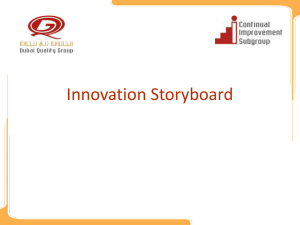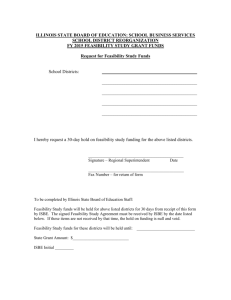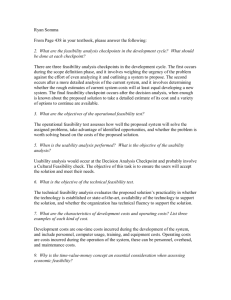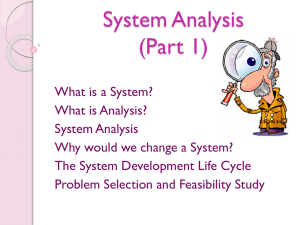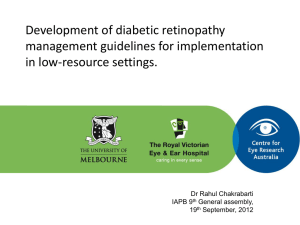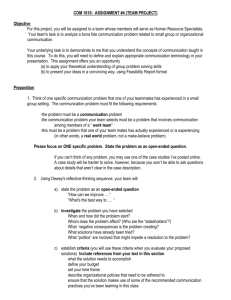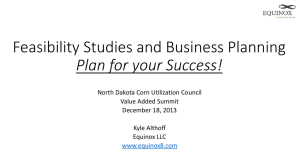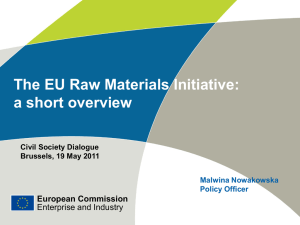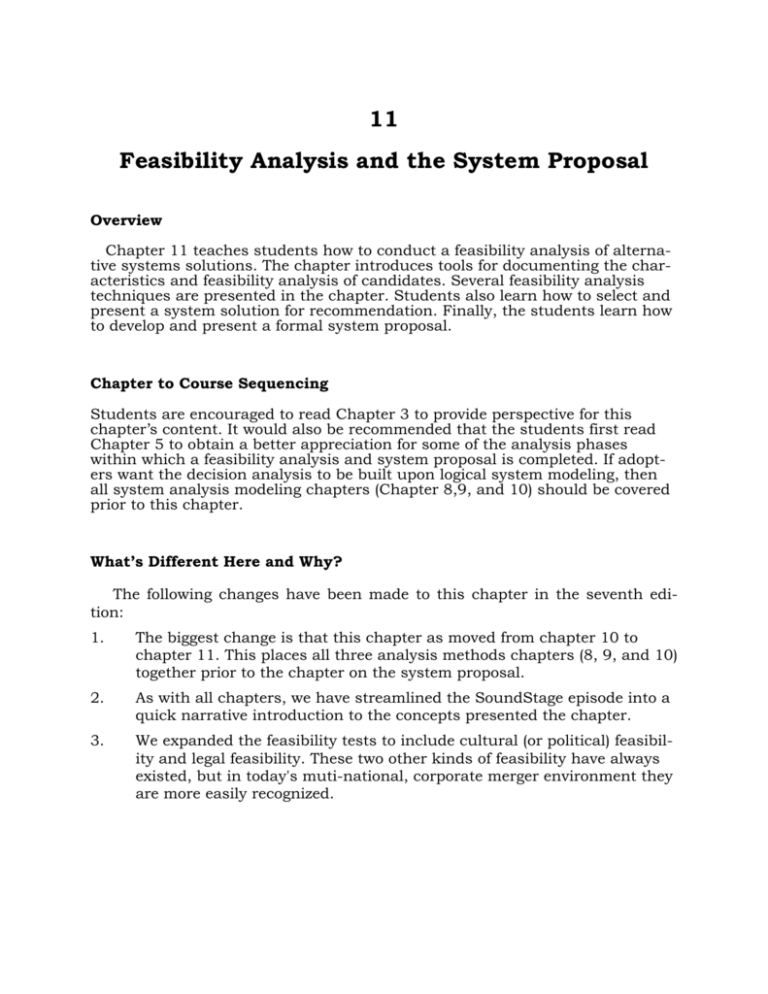
11
Feasibility Analysis and the System Proposal
Overview
Chapter 11 teaches students how to conduct a feasibility analysis of alternative systems solutions. The chapter introduces tools for documenting the characteristics and feasibility analysis of candidates. Several feasibility analysis
techniques are presented in the chapter. Students also learn how to select and
present a system solution for recommendation. Finally, the students learn how
to develop and present a formal system proposal.
Chapter to Course Sequencing
Students are encouraged to read Chapter 3 to provide perspective for this
chapter’s content. It would also be recommended that the students first read
Chapter 5 to obtain a better appreciation for some of the analysis phases
within which a feasibility analysis and system proposal is completed. If adopters want the decision analysis to be built upon logical system modeling, then
all system analysis modeling chapters (Chapter 8,9, and 10) should be covered
prior to this chapter.
What’s Different Here and Why?
The following changes have been made to this chapter in the seventh edition:
1.
The biggest change is that this chapter as moved from chapter 10 to
chapter 11. This places all three analysis methods chapters (8, 9, and 10)
together prior to the chapter on the system proposal.
2.
As with all chapters, we have streamlined the SoundStage episode into a
quick narrative introduction to the concepts presented the chapter.
3.
We expanded the feasibility tests to include cultural (or political) feasibility and legal feasibility. These two other kinds of feasibility have always
existed, but in today's muti-national, corporate merger environment they
are more easily recognized.
11-2
Chapter Eleven
LESSON PLANNING NOTES FOR SLIDES
The following instructor notes, keyed to slide images from the PowerPoint
repository, are intended to help instructors integrate the slides into their individual lesson plans for this chapter.
Slide 1
Chapter 11
Feasibility Analysis and
the System Proposal
McGraw-Hill/Irwin
Copyright © 2007 by The McGraw-Hill Companies, Inc. All rights reserved.
slide appearance after initial mouse click
in slide show mode
Slide 2
Objectives
• Identify feasibility checkpoints in the systems life
cycle.
• Identify alternative system solutions.
• Define and describe six types of feasibility and
their respective criteria.
• Perform various cost-benefit analyses using
time-adjusted costs and benefits.
• Write suitable system proposal reports for
different audiences.
• Plan for a formal presentation to system owners
and users.
11-2
Copyright © 2007 by McGraw-Hill Companies, Inc.
This repository of slides is intended to support the
named chapter. The slide repository should be
used as follows:
Copy the file to a unique name for your course
and unit.
Edit the file by deleting those slides you don’t
want to cover, editing other slides as appropriate
to your course, and adding slides as desired.
Print the slides to produce transparency masters
or print directly to film or present the slides using
a computer image projector.
Each slide includes instructor notes. To view
those notes in PowerPoint, click-left on the View
Menu; then click left on Notes View sub-menu.
You may need to scroll down to see the instructor
notes.
The instructor notes are also available in hardcopy as the Instructor Guide to Accompany Systems Analysis and Design Methods, 6/ed.
No additional notes.
Feasibility Analysis and the System Proposal
11-3
Teaching Notes
This slide shows the how this chapter's content
fits with the building blocks framework used
throughout the textbook. We are in the Decision
Analysis phase when all the logical DATA,
PROCESS, and COMMUNICATION analysis is
evaluated to produce a system proposal. For the
first time system designers are involved in the
process as well as systems analysts, owners,
and users.
Slide 3
11-3
Slide 4
Feasibility Analysis
No additional notes.
Feasibility – the measure of how beneficial or
practical an information system will be to an
organization.
Feasibility analysis – the process by which
feasibility is measured.
Creeping Commitment – an approach to
feasibility that proposes that feasibility should be
measured throughout the life cycle.
11-4
Slide 5
Feasibility Checkpoints During
Systems Analysis
No additional notes.
11-5
Copyright © 2007 by McGraw-Hill Companies, Inc.
11-4
Chapter Eleven
Slide 6
Six Tests For Feasibility
11-6
Slide 7
Operational feasibility – a measure of how well a
solution meets the system requirements.
Cultural (or political) feasibility - a measure of how
well a solution will be accepted in an organizational
climate.
Technical feasibility – a measure of the practicality of a
technical solution and the availability of technical
resources and expertise.
Schedule feasibility – a measure of how reasonable the
project timetable is.
Economic feasibility - a measure of the costeffectiveness of a project or solution.
Legal feasibility - a measure of how well a solution can
be implemented within existing legal/contractual
obligations.
Operational Feasibility
Conversion Notes
Cultural (or political) feasibility and legal feasibility
are new to the seventh edition.
Teaching Notes
It is useful to take an example information system
and explain how it might fail each test of feasibility. For example, a payroll system might fail legal
feasibility for a multi-national corporation faced
with national laws regarding the exportation of
employee data.
Emphasize that all candidates should be analyzed according to all of the above criteria.
Students should understand that rarely will any
one candidate solution be the most feasible candidate according to all criteria.
Conversion Notes
This is a new slide in the seventh edition.
• How well proposed system solves the
problems and takes advantage of
opportunities identified during the scope
definition and problem analysis phases
• How well proposed system satisfies
system requirements identified in the
requirements analysis phase
• Is the problem still worth solving?
11-7
Slide 8
Cultural (or political) feasibility
• Does management support the system?
• How do end users feel about their role in
the system?
• What end users may resist or not use the
system? How can this be overcome?
• How will the working environment
change? Can users and management
adapt to the change?
11-8
Copyright © 2007 by McGraw-Hill Companies, Inc.
Conversion Notes
This is a new slide in the seventh edition.
Feasibility Analysis and the System Proposal
Slide 9
Technical feasibility
11-5
Conversion Notes
This is a new slide in the seventh edition.
• Is the proposed technology or solution
practical?
• Do we currently possess the necessary
technology?
• Do we possess the necessary technical
expertise?
11-9
Slide 10
Schedule feasibility
Conversion Notes
This is a new slide in the seventh edition.
• Are specified deadlines mandatory or
desirable?
• Are mandatory deadlines realistic for
proposed solution?
11-10
Slide 11
Economic feasibility
Conversion Notes
This is a new slide in the seventh edition.
• During Scope Definition
• Do the problems or opportunities warrant the cost of
a detailed study and analysis of the current system?
• During Problem Analysis
• After a detailed study of the current system
• Better estimates of development costs and benefits
• During Decision Analysis
• Requirements now defined
• Development costs can be better estimated
11-11
Copyright © 2007 by McGraw-Hill Companies, Inc.
11-6
Chapter Eleven
Slide 12
Legal feasibility
•
•
•
•
•
Conversion Notes
This is a new slide in the seventh edition.
Copyrights
Union contracts
Legal requirements for financial reporting
Antitrust laws
National data and work laws
11-12
Slide 13
Information System Costs
• Development costs - one time costs that will
not recur after the project has been completed.
•
•
•
•
•
Personnel
Computer usage
Training
Supply, duplication, and equipment
Computer equipment and software
• Operating costs - costs that recur throughout
the lifetime of the system.
11-13
Slide 14
• Fixed costs — occur at regular intervals but at
relatively fixed rates.
• Variable costs — occur in proportion to usage.
Information System Benefits
• Tangible benefits are those that can be easily
quantified.
• Intangible benefits are those benefits believed
to be difficult or impossible to quantify.
• Fewer processing errors
• Increased throughput
• Decreased response time
• Elimination of job steps
• Increased sales
• Reduced credit losses
• Reduced expenses
11-14
Copyright © 2007 by McGraw-Hill Companies, Inc.
Teaching Notes
Our experience suggests that students will need
examples of each. The chapter includes several
examples. Try providing the students with a list of
items and ask them to classify them as a cost or
benefit and to distinguish between the type of
cost or benefit.
While students tend to understand intangible
benefits, they may have some difficulty in quantifying them. An exercise or two will help to reinforce the fact that intangible benefits can indeed
be quantified.
Teaching Notes
Our experience suggests that students will need
examples of each. The chapter includes several
examples. Try providing the students with a list of
items and ask them to classify them as a cost or
benefit and to distinguish between the type of
cost or benefit.
While students tend to understand intangible
benefits, they may have some difficulty in quantifying them. An exercise or two will help to reinforce the fact that intangible benefits can indeed
be quantified.
Feasibility Analysis and the System Proposal
Slide 15
Costs for a Proposed Solution
11-7
Teaching Notes
•
We often walk through this line-byline. Though this is not representative of every information system
project, it does illustrate typical
costs. For instance, note that programmer/analysts are needed after
the system goes into operation. Users always want some revisions.
11-15
Three Popular Techniques to
Assess Economic Feasibility
Slide 16
• Payback Analysis
• Return On Investment
• Net Present Value
Teaching Notes
While the textbook covers only the above popular
techniques, it is important to stress that there
may be others that organizations choose to use
in assessing the economic feasibility of an investment.
Stress the importance of determining the investment decision-making process or techniques
used by the organization. It should also be
pointed out that sometimes the techniques vary
according to the individuals involved.
11-16
Slide 17
Time Value of Money
• Used with all three cost-effectiveness
techniques.
• Concept that recognizes that a dollar today is
worth more than a dollar one year from now.
Teaching Notes
It is well worth going over this concept carefully
as it is the basis for all calculations on succeeding slides.
• Invest $100 at 2% for one year yields $102.
• So $100 today and $102 one year from today
represent the same value.
• Given $20,000 benefit from information system two
years from now and 10% return from other
investments, means that benefit is worth $16,528
today.
11-17
Copyright © 2007 by McGraw-Hill Companies, Inc.
11-8
Chapter Eleven
Slide 18
Payback Analysis
No additional notes.
Payback analysis – a technique for
determining if and when an investment will
pay for itself.
Payback period – the period of time that
will lapse before accrued benefits overtake
accrued and continuing costs.
11-18
Slide 19
Present Value Formula
Present value – the current value of a
dollar at any time in the future.
PVn = 1/(1 + i)n
Where n is the number of years and i is discount rate
Discount rate – a percentage similar to interest
rates that you earn on your savings.
11-19
Slide 20
Teaching Notes
While you may want your students to know this
formula, be sure to emphasize that PV tables are
available and spreadsheets generally include a
PV function.
Point out that the lifetime of an investment may
be dictated by an organization and its investment
decision makers.
Point out that the interest rate is often dictated.
Many companies choose to use the current prime
rate.
• In most cases the discount rate for a business is the
opportunity cost of being able to invest money in
other projects or investments
Payback Analysis for a Project
11-20
Copyright © 2007 by McGraw-Hill Companies, Inc.
No additional notes.
Feasibility Analysis and the System Proposal
Slide 21
11-9
Return-on-Investment Analysis
(ROI)
No additional notes.
Return-on-Investment (ROA) analysis – a
technique that compares the lifetime profitability
of alternative solutions.
The ROI for a solution or project is a percentage rate that
measures the relationship between the amount the business
gets back from an investment and the amount invested.
Lifetime ROI =
(estimated lifetime benefits – estimated lifetime costs) /
estimated lifetime costs
Annual ROI = lifetime ROI / lifetime of the system
11-21
Slide 22
Net Present Value (NPV)
Analysis
No additional notes.
Net present value – analysis technique that compares
annual discounted costs and benefits of alternative
solutions.
11-22
Slide 23
Candidate Systems Matrix
Candidate 1 Name
Candidate 2 Name
Candidate 3 Name
Stakeholders
Knowledge
Processes
Teaching Notes
This is a greatly simplified version of the Candidate Systems Matrix shown on the next slides.
The actual matrix can vary, but in any methodology the candidates should be evaluated in these
general areas.
Communications
Candidate Systems Matrix – a tool used to document
similarities and differences between candidate systems.
11-23
• Stakeholders - how system will interact with people and other
systems.
• Knowledge - how data will be implemented, how inputs will be
captured, how outputs will be generated.
• Processes - how processes will be built and implemented.
• Communications - how processes and data will be
distributed.
Copyright © 2007 by McGraw-Hill Companies, Inc.
11-10
Chapter Eleven
Slide 24
Sample Candidate Systems
Matrix
Characteristics
Portion of System
Computerized
Brief description of that portion
of the system that would be
computerized in this
candidate.
Benefits
Brief description of the
business benefits that would
be realized for this candidate.
Servers and
Workstations
A description of the servers
and workstations needed to
support this candidate.
Software Tools Needed
Software tools needed to
design and build the candidate
(e.g., database management
system, emulators, operating
systems, languages, etc.). Not
generally applicable if
11-24
applications software
packages are to be purchased.
Slide 25
Candidate 1
Candidate 2
COTS package Platinum
Plus from Entertainment
Software Solutions would be
purchased and customized
to satisfy Member Services
required functionality.
This solution can be
implemented quickly
because it’s a purchased
solution.
Technically architecture
dictates Pentium III, MS
Windows 2000 class servers
and workstations (clients).
MS Visual C++ and MS
Access for customization of
package to provide report
writing and integration.
Candidate 3
Member Services and
warehouse operations in
relation to order fulfillment.
Same as candidate 2.
Fully supports user required
business processes for
SoundStage Inc. Plus more
efficient interaction with
member accounts.
Same as candidate 1.
Same as candidate 2.
MS Visual Basic 5.0
System Architect 2001
Internet Explorer
MS Visual Basic 5.0
System Architect 2001
Internet Explorer
Same as candidate 1.
No additional notes.
Sample Candidate Systems
Matrix (cont.)
Characteristics
Application Software
Candidate 1
No additional notes.
Candidate 2
Candidate 3
Package solution
Custom Solution
Same as candidate 2.
Client/Server
Same as candidate 1.
Same as candidate 1.
(2) HP4MV
department laser
printers
(2) HP5SI LAN laser
printers
(2) HP4MV department laser
printers.
(2) HP5SI LAN laser printers
(1) PRINTRONIX bar-code printer
(includes software & drivers)
Same as candidate 2.
A description of the software
to be purchased, built,
accessed, or some
combination of these
techniques.
Method of Data
Processing
Generally some combination
of: on-line, batch, deferred
batch, remote batch, and realtime.
Output Devices and
Implications
A description of output
devices that would be used,
special output requirements,
(e.g., network, preprinted
forms, etc.), and output
considerations (e.g., timing
constratints)
Web pages must be designed to
VGA resolution. All internal
screens will be designed for SVGA
resolution.
11-25
Slide 26
No additional notes.
Sample Candidate Systems
Matrix (cont.)
Characteristics
Input devices and
Implications
Candidate 2
Candidate 3
Keyboard & mouse.
Candidate 1
Apple “Quick Take” digital camera
and software
(15) PSC Quickscan laser barcode scanners
(1) HP Scanjet 4C Flatbed
Scanner
Keyboard and mouse
Same as candidate 2.
MS SQL Server
DBMS with 1000GB
arrayed capability.
Same as candidate 1.
Same as candidate 1.
A description of input methods
to be used, input devices
(e.g., keyboard, mouse, etc.),
special input requirements
(e.g., new or revised forms
from which data would be
input), and input
considerations (e.g., timing of
actual inputs).
Storage Devices and
Implications
Brief description of what data
would be stored, what data
would be accessed from
existing stores, what storage
media would be used, how
much storage capacity would
be needed, and how data
would be organized.
11-26
Copyright © 2007 by McGraw-Hill Companies, Inc.
Feasibility Analysis and the System Proposal
Slide 27
11-11
Feasibility Analysis Matrix
Feasibility Analysis Matrix – a tool
used to rank candidate systems.
Weighting
Candidate 1
Candidate 2
Teaching Notes
The weightings serve to make some kinds of
feasibility more important in the rankings than
others kinds.
The weightings should add up to 100%.
Candidate 3
Description
Operational Feasibility
Cultural Feasibility
Technical Feasibility
Schedule Feasibility
Economic Feasibility
Legal Feasibility
Ranking
11-27
Slide 28
Sample Feasibility Analysis
Matrix
Wt
Candidate 1
Purchase commercial
off-the-shelf package for
member services.
Candidate 2
Write new application inhouse using new company
standard VB.NET and SQL
Server database
Candidate 3
Rewrite current in-house
application using
Powerbuilder.
15%
Supports only Member
Services requirements.
Current business
process would have to
be modified to take
advantage of software
functionality. Also there
is concern about security
in the system.
Fully supports userrequired functionality.
Fully supports userrequired functionality.
Description
Operational
feasibility
Cultural
Feasibility
15%
Score: 60
Possible user resistance
to non-standard user
interface of proposed
purchased package.
Score: 100
No foreseeable problems.
Score: 100
No additional notes.
Score: 100
No foreseeable problems.
Score: 100
Score: 70
11-28
Slide 29
Sample Feasibility Analysis Matrix
(cont.)
Technical
feasibility
Wt
20%
Candidate 1
Candidate 2
Candidate 3
Current production
release of Platinum Plus
package is version 1.0
and has been on the
market for only 6 weeks.
Maturity of product is a
risk, and company
charges and additional
monthly fee for technical
support.
Solution requires writing
application in VB .NET.
Although current
technical staff has only
Powerbuilder experience,
it should be relatively
easy to find
programmers with VB
.NET experience.
Required to hire or train
Java J2EE expertise to
perform modifications for
integration requirements.
Although current technical
staff is comfortable with
Powerbuilder, management
is concerned about
acquisition of Powerbuilder
by Sybase Inc. MS SQL
Server is the current
company standard for
database, which competes
with Sybase DBMS. We
have no guarantee that
future versions of
Powerbuilder will "play well"
with our current version of
SQL Server.
Score: 50
Score: 60
Score: 95
No additional notes.
11-29
Copyright © 2007 by McGraw-Hill Companies, Inc.
11-12
Chapter Eleven
Slide 30
Sample Feasibility Analysis Matrix
(cont.)
Economic
feasibility
Wt
30%
Candidate 1
Candidate 2
Candidate 3
Cost to
develop:
Approx. $350.000
Approx. $418.000
Approx. $400.000
Payback
(discounted):
Approx. 4.5 years
Approx. 3.5 years
Approx. 3.3 years
Net present
value:
Approx. $210,000
Approx. $307,000
Approx. $325,000
See Attachment A
See Attachment A
See Attachment A
Score: 60
Score: 85
Detailed
calculations:
No additional notes.
Score: 90
11-30
Slide 31
Sample Feasibility Analysis Matrix
(cont.)
Wt
10%
Less than 3 months
Legal
feasibility
10%
No foreseeable problems No foreseeable problems No foreseeable problems
Weighted
score
100%
Schedule
feasibility
Candidate 1
Candidate 2
9-12 months
Score: 95
Score: 80
No additional notes.
Candidate 3
9 months
Score: 85
Score: 100
Score: 100
Score: 100
67
92.5
87.5
11-31
Slide 32
The System Proposal
System proposal – a report or
presentation of a recommended solution.
• Usually formal written report or oral
presentation
• Intended for system owners and users
11-32
Copyright © 2007 by McGraw-Hill Companies, Inc.
No additional notes.
Feasibility Analysis and the System Proposal
Slide 33
Length of the Written Report
11-13
Conversion Notes
This is a new slide for the seventh edition
• To Executive-level managers - one or two
pages
• To Middle-level managers - three to five
pages
• To Supervisory-level managers - less than
10 pages
• To clerk-level personnel - less than 50
pages.
11-33
Slide 34
Formats for Written Reports
• factual format - traditional and best suited to readers
interested in facts and details as well as conclusions.
• administrative format - modern, result-oriented format
preferred by managers and executives.
Factual Format
Conversion Notes
The definitions were added to this slide for the
seventh edition.
Administrative Format
I. Introduction
II. Methods and procedures
I. Introduction
II. Conclusions and recommendations
III. Facts and details
III. Summary and discussion of facts
and details
IV. Discussion and analysis of
facts and details
V. Recommendations
VI. Conclusion
IV. Methods and procedures
V. Final conclusion
VI. Appendixes with facts and details
11-34
Slide 35
Organization of the Written
Report
No additional notes.
• Primary elements present the actual
information that the report is intended to
convey.
• Secondary elements package the report
so the reader can easily identify the report
and its primary elements.
11-35
Copyright © 2007 by McGraw-Hill Companies, Inc.
11-14
Chapter Eleven
Slide 36
Secondary Elements for a
Written Report
No additional notes.
Letter of transmittal
Title page
Table of contents
List of figures, illustrations, and tables
Abstract or executive summary
(The primary elements--the body of the report, in either the factual
or administrative format--are presented in this portion of the report.)
Appendices
11-36
Slide 37
Writing the Report
Conversion Notes
The bulleted guidelines are new to the seventh
edition.
• Paragraphs should
convey a single idea.
• Sentences should not
be too complex.
• Write in active voice.
• Eliminate jargon, big
words, and deadwood.
11-37
Slide 38
System Proposal – formal
presentations
Formal presentation – a special meeting used
to sell new ideas and gain approval for new
systems. They may also be used for any of
these purposes:
11-38
•
•
•
•
•
•
•
Sell new system
Sell new ideas
Head off criticism
Address concerns
Verify conclusions
Clarify facts
Report progress
Copyright © 2007 by McGraw-Hill Companies, Inc.
No additional notes.
Feasibility Analysis and the System Proposal
Slide 39
11-15
Typical Outline and Time Allocation
for an Oral Presentation
No additional notes.
I. Introduction (one-sixth of total time available)
A. Problem statement
B. Work completed to date
II. Part of the presentation (two-thirds of total time available)
A. Summary of existing problems and limitations
B. Summary description of the proposed system
C. Feasibility analysis
D. Proposed schedule to complete project
III. Questions and concerns from the audience (time here is not to be included in the time
allotted for presentation and conclusion; it is determined by those asking the questions and
voicing their concerns)
IV. Conclusion (one-sixth of total time available)
A. Summary of proposal
11-39
Slide 40
B. Call to action (request for whatever authority you require to continue systems
development)
No additional notes.
Guidelines for Visual Aids
Source: Copyright
Keith London
11-40
Slide 41
Conducting the Formal
Presentation
Conversion Notes
This slide is new to the seventh edition.
• Dress professionally.
• Avoid using the "I" word when making the
presentation.
• Maintain eye contact with the group and
keep an air of confidence.
• Be aware of your own mannerisms.
11-41
Copyright © 2007 by McGraw-Hill Companies, Inc.
11-16
Chapter Eleven
Slide 42
When Answering Questions
• Always answer a question seriously, even
if you think it is a silly question.
• Answer both the individual who asked the
question and the entire audience.
• Summarize your answers.
• Limit the amount of time you spend
answering any one question.
• Be honest.
11-42
Copyright © 2007 by McGraw-Hill Companies, Inc.
Conversion Notes
This slide is new to the seventh edition.
Feasibility Analysis and the System Proposal
11-17
Answers to End of Chapter Questions and Exercises
Review Questions
1. Feasibility should be measured throughout the system development life cycle, since the scope and complexity of a project may change. It is especially
true when we have come to better understand the initial problems and opportunities identified. Thus, a project’s feasibility may change.
2. The first checkpoint is during the scope definition phase. During this
phase, the feasibility analysis is conducted to assess whether the problem is
urgent or serious enough to justify the cost of moving forward with a more
detailed analysis
The second checkpoint is after the problem analysis is completed. By this
checkpoint, there is a better understanding of the problem(s) and the systems analysts will be able to more accurately estimate the development
costs (although they will still be very approximate since user requirements
have not yet been completely defined) and the benefits that a new system
may bring.
The third checkpoint is at the decision analysis phase. During the decision
analysis phase, candidate solutions are defined and evaluated in detail.
Since problems and requirements should be well known by this point, the
feasibility analysis should also be more accurate.
3. The objectives of operational feasibility are to measure the degree to which
the solution will resolve the problem, and the degree to which the organization is likely to accept the solution
4. It is important because no matter how workable the solution may be, it
could still fail if the end-users or management resist and do not accept the
solution. The support of management and end-users is critical to the success of a system.
5. The usability analysis is generally performed in the later stages of the system life cycle in order to determine operational feasibility, specifically to
measure how well the user interfaces work. A functional system prototype,
if available, may be used in this analysis.
The objective is to determine how usable the system’s user interfaces are by
measuring ease of learning, ease of use and user satisfaction with the interface. The analysis involves seeing where in the system the users are more
likely to make mistakes and to identify any functionality that is confusing or
Copyright © 2007 by McGraw-Hill Companies, Inc.
11-18
Chapter Eleven
too complex. The reactions of the users and their productivity are examined
as well.
6. Technical feasibility looks at whether the proposed solution is practical from
a technology standpoint, whether the organization will need to acquire the
required technology, and whether the organization has the necessary technical expertise to support the proposed solution.
7. System development costs are one-time costs that will not be incurred again
after the project is finished.
Example: Personnel costs such as the salaries (and benefits if they are permanent employees) for the members of the project team, initial training, and
acquisition costs for hardware and software.
Operating costs, on the other hand, are ongoing costs to support and maintain the system until it is retired or replaced. .
Example: Personnel costs for support staff, ongoing training costs for new
personnel, computer usage time, and maintenance agreement costs for
computer hardware and software.
8. •
•
•
•
•
•
•
Fewer processing errors
Greater throughput
Less response time
Elimination of job steps
Increased sales
Reduced credit losses
Reduced expenses
9. The time value of money means that the money ou have today is worth more
than the same amount of money one year from now, because it could be invested and accrue interest. The time value of money concept is used by the
three most popular techniques for determining economic feasibility, because
it provides a method for time-adjusting costs and benefits for comparing
projects that have different usable lives.
10. • Payback analysis
• Return-on-Investment (ROI) analysis
• Net present value
11. The candidate systems matrix is used to compare and document the characteristics of the different candidate systems; it is a comparative rather
than analytical tool
Copyright © 2007 by McGraw-Hill Companies, Inc.
Feasibility Analysis and the System Proposal
11-19
The feasibility analysis matrix is used to analyze and rank the different
candidate systems. It is usually used in conjunction with the candidate
systems matrix to provide a complete comparison, analysis and ranking of
the different proposed systems.
12. The factual format is a traditional format that begins with project background information, goes through methodology, facts, details and analysis,
and then ends with the recommendation and conclusion. This format is
geared to those who need to closely review detailed information, such as
systems users, rather than a summary.
The administrative format is frequently used when the intended or primary audience is managers and executives who do not have the time to
read through a lengthy report. This format focuses on delivering the information they are interested in by beginning with the report conclusions
and/or recommendations.
13. Initial preparation: define objectives, scope, and strategy; clarify material;
define readership and method Î Outline: headings; illustration titles Î
Draft text and illustrations Î Rewrite/ Edit Î Final type Î Proofread Î
Reproduce/ bind Î Check Î Distribute
14. Presentations are beneficial because presenters can get feedback and responses immediately. The audience can have interaction with the presenter face to face that cannot be achieved in written words.
The disadvantage is that the audience may easily forget the presentation
because the words are spoken and the visual aids are only temporary.
15. Copies of the written report should be sent to the audience in order to provide them with a more permanent form of information.
Problems and Exercises
1. a. The creeping commitment approach calls for determining the feasibility
of a project not only at the beginning of the project, but continuing to
measure feasibility throughout the project life cycle. This approach is
based upon the possibility (and in some cases, unfortunately, the probability) that a project which was feasible initially may become infeasible
at a later point before the project is completed.
b. Scope can and often does change during a project, in addition, as analysis progresses, the project may turn out to be more complex than originally perceived. Further, in the volatile atmosphere and frenetic pace of
today’s business world, business drivers and project sponsors may
change rapidly. All these factors may have a negative impact upon the
feasibility of a project.
Copyright © 2007 by McGraw-Hill Companies, Inc.
11-20
Chapter Eleven
c. In general, a project should be canceled if it becomes infeasible, regardless of the amount of resources it has consumed. A basic tenet of business management is to not throw good money after bad. This is definitely true for projects, not only for the one-time costs, but also why
spend money on ongoing operations for a system that is not feasible?
2. a. The checkpoints occur at scope definition, problem analysis, and decision
analysis.
b. Feasibility determination is very approximate at the systems analysis
checkpoint, but is becomes increasingly refined and more accurate
through each checkpoint as more information becomes known.
c. All feasibility analysis checkpoints are critical, but the decision analysis
checkpoint is generally considered the most critical because, as the name
implies, this is the decision point on whether to proceed, which option to
choose, and to commit the organization’s resources to construction and
implementation, which is generally considered the most expensive part
of the project.
3. The four feasibility test categories, and their measurement criteria, are:
1. Operational feasibility
i. Is the problem important or urgent enough to solve? Will the solution
work?
ii. How do or will stakeholders feel about the solution; is it a good “fit”
for the organization?
2. Technical feasibility
i. Is the solution practical?
ii. Does the organization have the technology needed for the solution?
iii. Does the organization have the technical expertise needed for the solution?
3. Schedule feasibility – is the schedule “doable?” If not, can it be made doable?
4. Economic feasibility - Are the benefits to be derived from the project
worth the costs involved?
4. The usability analysis tests the system’s user interfaces. Accordingly, your
plan should include:
a. How test participants will be selected, which groups do they represent,
and how many are needed.
b. What sort of facilities will be needed, and whether the participants will be
observed or videotaped.
Copyright © 2007 by McGraw-Hill Companies, Inc.
Feasibility Analysis and the System Proposal
11-21
c. The usability criteria, i.e., ease of learning, ease of use and user satisfaction as the core criteria. If there are other specific things that need to be
evaluated, they should be identified in your plan.
d. The survey or data collection instrument that you will use to measure the
usability criteria described above.
e. The schedule for testing.
f. How you will report the results
5. In this exercise, you are expected to go through the process for estimating
the costs of development and ongoing support. The primary intent is to
identify all the different areas where costs can be incurred, and to develop a
methodology for estimating what those costs will be. While there is not a
“correct” answer per se, your worksheet should reflect the following:
a. One-time costs should be shown separately from ongoing costs.
b. Personnel costs should reflect all staff involved in the project, their
hourly costs, and the number of hours they will be committed to the project.
c. Contract costs for the consultants
d. Training
e. Purchase costs for new hardware
f. Any miscellaneous costs
g. Ongoing operating costs should also break out fixed and variable costs.
6. The expected tangible benefits would be reduced labor for both the employees completing the activity reports and the support staff who have to compile them and produce summary activity reports. Tangible benefits should
also include fewer errors that need to go back for correction, since the system can be expected to catch them at point of data entry, and elimination of
job steps.
The calculations for estimating the annual savings should closely follow
the example provided in the textbook. E.g., estimate the average time savings for the impacted groups, i.e., all employees and the support staff, estimate the average hourly labor costs for each group, do your calculations,
check it for reasonableness, and you will have an estimate of the tangible
benefits to be realized.
7. #2 offers the highest ROI, but none meets the organization’s minimum acceptable lifetime ROI.
Estimated
Lifetime
Benefits
Candidate Solution #1: $640,000
Candidate Solution #2: $640,000
Estimated
Lifetime
Costs
ELB – ELC
Lifetime
ROI
$ 372,000
$ 360,000
$268,000
$280,000
72%
77%
Copyright © 2007 by McGraw-Hill Companies, Inc.
11-22
Candidate Solution #3: $640,000
Chapter Eleven
$ 385,000
$255,000
66%
8. The different approaches for identifying candidate solutions include:
a. Suggestions from users
b. Organization’s IT Architecture Plan
c. Brainstorming with project team members
d. Consultants
e. Reviewing pertinent literature
You may choose any approach, but your answer needs to support it by explaining why the chosen approach is more likely to identify the best solution
than the other methods.
9. There are many potential candidate solutions. The descriptions in the matrix should make it clear whether the candidate solutions will be developed
in-house by staff or a purchased COTS solution. The benefits that are described should focus on the business benefits, not the technological benefits
other than how they help meet the business objects Some of the solutions
your instructor may expect to see described in the method of data processing probably include client/service and web-based application approaches.
A candidate solution that includes a data analysis module should also be
identified. Also, each candidate solution description should be “standalone,” i.e., there should not be any comparison of one solution versus another at this point.
10. The specific weighting factors you use are subjective, but since the CEO
has emphasized the need to implement a solution as quickly as possible,
the weighting factor schedule feasibility should reflect this priority. Given
the fairly specialized nature of the application, a COTS solution will probably not score high on operational feasibility. In terms of technical and perhaps economic feasibility, a web-based candidate solution should probably
score high in these areas.
11. Since the audience for this report is executive-level managers, you should
use the administrative format and limit the length of the report to one or
two pages. The report should follow the guidelines described in the chapter, be consistent with the feasibility analysis matrix, and include a letter of
transmittal.
12. You have a good deal of creative freedom with the content and organization
of your set of PowerPoint slides, but they should be in line with some basic
guidelines:
a. The PowerPoint slides are a visual aid only; you are the main presenter.
Therefore, each slide should contain no more than a single idea.
Copyright © 2007 by McGraw-Hill Companies, Inc.
Feasibility Analysis and the System Proposal
11-23
b. The PowerPoint slides should contain just enough words on each slide
to convey the idea. The slides shouldn’t be narratives, crowded with
bullet items, or so brief no one can figure them out!
c. The slides, like your presentation, should be in a logical order, and not
haphazardly organized.
d. The number of slides should map closely to the number of points you
are covering in your presentation. If there are more than a couple of
dozen slides, either your PowerPoint presentation is definitely too detailed, or you are definitely trying to cover too much detail in your executive-level presentation.
e. The color design should not be garish or make the text hard to read.
f. Special effects should be conservative, and far and few between. They
may be funny the first time (or not), but they definitely get annoying and
distracting thereafter.
13. Some of the “don’ts” include:
1.
2.
3.
4.
5.
6.
7.
8.
9.
Not be prepared for the presentation
Not hit the main target – the feasibility analysis – quickly enough
Not use any visual aids or handouts.
Not keep the presentation to an appropriate length
Not say “we” or “our”
Not anticipate their questions and be prepared for them
Not make eye contact with the group
Not be aware of your verbal and physical mannerisms
Not take a question seriously, regardless of how asinine you might
really think it is
10. Not be honest in your response to a question to which you don’t know
the answer, but try to bluff instead
11. Not answer to the entire group the question from an individual
12. Dress over-casually, even if your executives do
Project and Research
1. Open-ended; responses should be insightful, logical, well reasoned and well
thought out, and demonstrate an understanding of the essential similarities
and differences in software development projects versus construction projects. For example, response could and should include a discussion pointing
out that the body of knowledge on construction projects is far more mature
than for software engineering, and that information systems are inherently
more difficult to design because the rules on which they are built are far
less cut-and-dried and far more fluid.
2. Students have carte blanche as to their candidate solutions. Expect that
the majority will include options that employ modern (or at least more modCopyright © 2007 by McGraw-Hill Companies, Inc.
11-24
Chapter Eleven
ern) technology, such as a client/server-based system for field office data
entry, web-based applications, or laptops with handwriting recognition. As
always, responses should be consistent with the tools and techniques described in the textbook, logical and reasonable, and should demonstrate an
understanding of the basic concepts of a feasibility analysis.
3. Response should closely follow the economic feasibility tools and techniques
described in the book, and should be mathematically correct. Analysis of
each candidate solutions should be unbiased and the analysis of the lowerscoring candidate solutions should not fall into the common trap of being
pro forma.
4. Report should be three to five pages, and should use the “administrative
format.” The report should be consistent with the instructions included in
the textbook and should be in alignment with the feasibility analysis matrix.
Report should also be appropriately professional in content, tone and presentation.
5. Description of preparatory steps should be generally consistent with the
steps given in the textbook, but students may choose alternative or expanded paths. The PowerPoint presentation should be appropriate in
length, content and format for the subject matter and audience. It should
also follow established principles of effective design. The response to the
most critical thing to know is subjective, but will probably be something
along the lines of knowing your audience, knowing your subject matter,
knowing what questions to anticipate, etc.
6. This question is intended to expose the student to the wide range of tools
and techniques for preparing feasibility study report, so the response can be
open-ended. Responses to the ideal FSR template should indicate whether
the student has a basic grasp, both in concept and in practice.
Mini-Cases
1. Note to professor: Students will have differing conclusions based on the initial assumptions they make. Have students share both their assumptions
and their conclusions with the rest of the class. Have students note the difference. For grading, observe the logic and research that was used to make
assumption and to derive the conclusions. I.e. while it is ok for students to
have differences in their work, it is not ok for the work to be un-researched,
or lacking in solid reasoning.
2. Note to professor: Clearly, the choice of functionality and underlying technologies will impact the feasibility of the project – but only minimally, since
ecommerce is very much of an established sales channel. The affect that is
Copyright © 2007 by McGraw-Hill Companies, Inc.
Feasibility Analysis and the System Proposal
11-25
had will depend on the assumptions the student(s) made about the business
and its employees, customers, etc.
3. Note to professor: Students need to be very thorough in their assessment of
intangible costs and benefits as well as the tangible ones. They should do
this by utilizing surveys, existing data on other ecommerce sites, etc. They
should also be quite aware that forecasts of demand and gaining market
share will be strongly affected by consumer behavioral issues. Who generally does the food shopping? How do they feel about online shopping for
groceries? Does the target market feel strongly about delivery vs. pickup of
their food? Encourage students to explore the “people” side of monetary issues in IT.
4. Note to professor: Delays or deadline problems will most likely not be due
to technical difficulties, but rather behavioral or resource related problems.
For example, a key member of the team gets the flu and is unable to work
for a week. Remind students that life issues can and will happen. They
need to consider the impact of the unexpected on their timeline.
Team and Individual Exercises
There are no answers to this section.
Copyright © 2007 by McGraw-Hill Companies, Inc.

